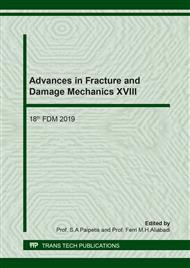[1]
L.A. Obergefell, T.R. Gardner, I. Kaleps and J.T. Fleck: Articulated total body model Enhancements Vol.2: User's Guide (1998).
Google Scholar
[2]
J.S. Ruan, C. Zhou, T.B. Khalil and A.I. King: Techniques and Applications of Finite Element Analysis of the Biomechanical Response of the Human Head to Impact (CRC Press LLC, 2001).
DOI: 10.1201/9781420049527.ch-07
Google Scholar
[3]
J.S.H.M. Wismans: Injury biomechanics (Eindhoven University of Technology, Division of Fundamentals (WFW), 1994).
Google Scholar
[4]
H.J. Mertz, P. Prasad and G. Nusholtz: SAE Technical Paper 960099 (1996).
Google Scholar
[5]
A. De Luca and F. Caputo: AIMS Materials Science Vol. 4 (5) (2017), p.1165–1185.
Google Scholar
[6]
A. Califano: AIP Conference Proceedings 1981, 020144 (2018).
Google Scholar
[7]
F. Caputo, G. Lamanna, A. De Luca and V. Lopresto: AIP Conference Proceedings 1599, 334 (2014).
Google Scholar
[8]
G. Lamanna, C. Opran and D. Perfetto: AIP Conference Proceedings 1981, 020136 (2018).
Google Scholar
[9]
D. Perfetto, A. Greco and F. Caputo: AIP Conference Proceedings 1981, 020137 (2018).
Google Scholar
[10]
R. Borrelli, A. Riccio, A. Sellitto, F. Caputo and T. Ludwig: Compos. Sci. Technol. Vol. 115 (2015), pp.43-51.
Google Scholar
[11]
F. Caputo, G. Lamanna and A. Soprano: Procedia Engineer. Vol. 10 (2011), pp.2988-2993.
Google Scholar
[12]
L. Xiaochuan, G. Jun, B. Chunyu, S. Xiasheng and M. Rangke: Chinese J. Aeronaut. Vol. 28(2) (2015), pp.447-456.
Google Scholar
[13]
M. Guida, F. Marulo and S. Abrate: Prog. Aerosp. Sci. Vol. 98 (2018), pp.106-123.
Google Scholar
[14]
F. di Napoli, A. De Luca, F. Caputo, F. Marulo, M. Guida and B.Vitolo: Int. J. Crashworthines. (2018).
Google Scholar
[15]
F. Caputo, A. De Luca, A. Greco, S. Maietta, A. Marro and A. Apicella: Frattura ed Integrità strutturale Vol. 12 (2018), pp.191-204.
DOI: 10.3221/igf-esis.43.15
Google Scholar
[16]
F. Caputo, A. De Luca, A. Greco, A. Marro, A. Apicella, R. Sepe and E. Armentani: Adv. Mater. Sci. Eng. Vol. 43 (2018), pp.1-21.
Google Scholar
[17]
K.E. Jackson and E.L. Fasanella in: Design, Testing, and Simulation of Crashworthy Composite Airframe Structures at NASA Langley Research Center, volume 8 of Comprehensive Composite Materials II, chapter, 8.15, Elsevier (2018).
DOI: 10.1016/b978-0-12-803581-8.10063-3
Google Scholar
[18]
D. I. Gransden and R. Alderliesten: Int. J. Crashworthines. Vol. 22 (2017), pp.401-414.
Google Scholar
[19]
R. Sepe, R. Citarella, A. De Luca and E. Armentani: Adv. Mater. Sci. Eng. Vol. 2017 (2017), Article ID 1092701.
Google Scholar
[20]
E. Armentani, R. Citarella and R. Sepe: Eng. Fract. Mech. Vol. 78 (2011), pp.1717-1728.
Google Scholar
[21]
R. Sepe, E. Armentani and F. Caputo: Frattura ed Integrità Strutturale Vol. 10 (2016), pp.534-550.
DOI: 10.3221/igf-esis.35.59
Google Scholar
[22]
C. Lawrence, E.L. Fasanella, A. Tabiei, J.W. Brinkley and D.M. Shemwell: NASA/TM—2008-215198 (2008).
Google Scholar
[23]
M. Waimer, D. Kohlgrüber, D. Hachenberg and H. Voggenreiter: Compos. Struct. Vol. 105 (2013), pp.288-299.
Google Scholar
[24]
M. Waimer, D. Kohlgrüber, R. Keck and H. Voggenreiter: CEAS Aeronaut. J. Vol. 4 (2013), pp.265-275.
Google Scholar
[25]
D. Perfetto, A. De Luca, G. Lamanna, A. Chiariello, F. Di Caprio, L. Di Palma and F. Caputo: Procedia Structural Integrity Vol. 12 (2018), pp.380-391.
DOI: 10.1016/j.prostr.2018.11.079
Google Scholar
[26]
F. Caputo, G. Lamanna and A. Soprano: SDHM Vol.7, no.4 (2011), pp.283-296.
Google Scholar
[27]
G. Lamanna, F. Caputo and A. Soprano: AIP Conference Proceedings 1459, 353 (2012).
Google Scholar


